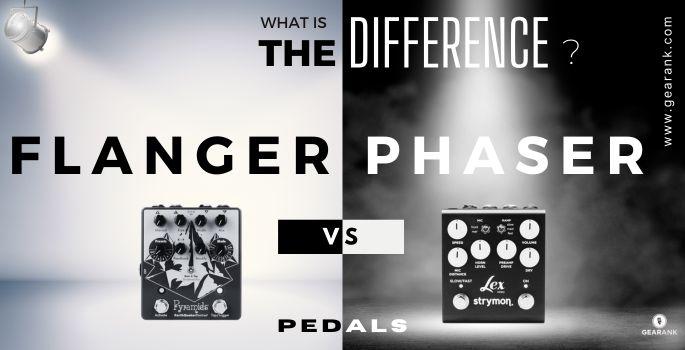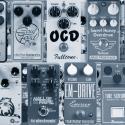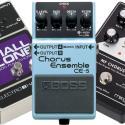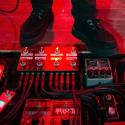Flanger Vs Phaser Pedals: What is The Difference?

If you play guitar, exploring modulation pedals will surely be a part of your journey.
We will be comparing two popular modulation effects: flanger vs phaser. These two share many similarities, but they also have significant differences.
Some players need clarification with these two pedals. Many may have to do with these two having almost the same effect on the sonic spectrum.
But there's a lot more to it than that.
So, in this guide, we'll show you all the similarities and key differences between the two and help you better understand both.
Understanding Modulation
Before going into the flanger vs phaser comparison, I want to define what modulation or a modulation pedal is.
Modulation pedals add modulation effects that is commonly used to vary guitar tone in music. They add depth (intensity or amplitude) and motion (speed or frequency) by modifying the audio signal of your guitar or other instrument.
These pedals include tremolo, vibrato, chorus, phaser, and flanger. They fall into the modulation effects pedal category.
An example of a genre that uses them is psychedelic music. The unique sound these pedals produce helps achieve the identity of the genre.
We can already draw similarities in our flanger vs phaser comparison as they fall into the same category.
Note: Modulation effects such as flangers and phasers can be placed at the preamp stage. Putting it before the preamp is best if you're not sending drive or dirt tones to your amp. On the other hand, if you're sending drive or dirt tones to your amp. We recommend placing your modulation pedal in the effects loop of your amp. If your amp doesn't have an effects loop, put your modulation effects after your drive or dirt pedals. This way, you'll have a clearer tone. However, these are not set in stone, as you may find creative uses for pedal placement.
For more details about the subject of effects pedal placement, check this out: Guitar Pedal Order.
Flanger vs Phaser: Closer Analysis
Let's take a closer look at each pedal separately. To understand both better before we continue with our phaser vs flanger comparison.
What Is A Flanger Pedal?
Flanger pedals are some of the most widely used pedals in rock music. Their effects can be used in both analog and digital recordings. Even today, musicians and sound engineers love to add a flanging effect to their mixes.
What does the flanger do?
A flanger duplicates the same note, so it has two identical audio signals. The flanger takes the two signals and mixes them. But, it adds a very slight delay effect to one signal. This delay continues throughout the audio with slight variations to its length.
The delayed signal mixes with the original signal to create a new waveform. The result is the volume of specific frequencies is reduced or increased throughout.
This is known as the flanger effect or as comb filtering.
The name comb filtering comes from the visual appearance of this effect on a frequency spectrum. The peaks and notches resemble a comb if you look at the end of a flanger sound frequency spectrum. With the delay time continuously sweeping, the flanger creates a swept comb filter that changes the frequency range.
Different ways to achieve the flanging effect in your music.
-
Artificial Flanging
-
Tape Flanging
Artificial flanging is what you get from using a flanger plugin or flanger pedal. You may also want to use a micro flanger. These are the same as flanging pedals but are smaller with an easier interface. They still achieve the same artificial effect.
On the other hand, tape flanging uses a tape machine. You have two audio reels, but you slow one down manually. This still achieves the same effect, but it's an outdated method.
One notable player who used a flanger is Eddie Van Halen. The flanger is crucial to get the tone of his iconic tapping section for his solo on the instrumental track "Eruption."
What Is A Phaser Pedal?
Next, let's examine the phaser.
Phasers are modulation effect pedals that create numerous notch filters and use them to change the input signal. Because they 'shift' the signal through filters, they are known as phase shifters.
What effect do these filters have on your input signal?
These filters change the frequencies of your input signals to create various movements and sounds. They can remove specific frequencies. This creates a 'sweeping' phaser effect.
How many notches your phaser has can vary. The older the phaser, the fewer notches it may have.
Some common filters on modern phasers control:
-
Rate - This makes the sweeping faster or slower.
-
Depth - This changes the intensity of the sweep.
-
Resonance - This emphasizes different tones in the sweep, making it higher or lower.
-
Effects Level - Allows you to change the number of stages in your phaser. So, you can switch from 4-stage to 12-stage while using the same phase shift pedal.
How many stages your audio passes through depends on the phaser. For example, a modern digital phaser pedal can have between 4 to 12 stages. An older phaser has much fewer stage settings available.
An example is what David Gilmour used in "Have a Cigar" and "Shine on You Crazy Diamond." He used an MXR Phase 90, a 4-stage phaser with similar qualities as the Uni-Vibe.
Phaser vs Flanger Comparison
Now, let's compare flangers and phasers together. This way, you can understand how they differ in detail!
Audio Signal
Similarity:
-
Both flanger and phaser effects mix a dry carrier signal with a wet signal.
Difference:
-
I mentioned earlier how flangers will duplicate the audio, so there are two signals. One signal is delayed, and the other remains dry. Then, the delayed and original signals mix to achieve that iconic flanger sound.
-
Phasers do the same thing. It splits the audio into two, one signal is phase shifted through the filters, and returns it to the original signal for the final audio.
Tone
Similarity:
-
Both flanging and phase shifting create sweeping tones. However, these tones are very different in quality.
Difference:
-
The flanger sweep is much more metallic in tone. It features exaggerated resonance that gives it a unique sound - almost like a jet engine passing by. It's harsh and great for rock and metal music.
-
Early phase shifters were made to replicate the iconic sound of rotating organ speakers. Over time, they were developed to produce a gentler version of the flanger sweep.
So, a phaser produces a softer sweep that makes it great for all genres of music production. Some people I have met have even compared the sound of phasers to hearing multiple voices.
Tone
Similarity:
-
Both flanging and phase shifting create sweeping tones. However, these tones are very different in quality.
Difference:
-
The flanger sweep is much more metallic in tone. It features exaggerated resonance, giving it a unique sound - almost like a jet engine passing by. It's harsh and great for rock and metal music.
-
Early phase shifters were made to replicate the iconic sound of rotating organ speakers. Over time, they were developed to produce a gentler version of the flanger sweep.
-
So, a phaser creates a softer sweep that makes it great for all genres of music production. They have a characteristic "whooshing" sound compared to the flanger's "metallic" timbre.
Use of Delay
Similarity:
-
Phasers and flangers sound similar because they both use wet and dry signals. However, one of the critical differences between phasers and flangers is the delay properties.
Difference:
-
Flangers add a time delay to one of the signals to change the frequency band. It varies the delay time in a constant cycle. The delay time is modulated and controlled by a low-frequency oscillator.
-
The original signal then mixes with the wet for a unique effect.
-
Phasing pedals, however, do not use delays at all. All-pass filters cause the phase difference.
-
All pass filters are filters that all frequencies go through. They pass through the all pass filter with an unchanged gain but adjust phase relationships at different frequencies.
-
The outputs are then combined with the original signal. Notches form where the frequencies are out of phase due to the filters. This is how phasers get their sound.
Note: Phasers and flangers create similar sounds but use different methods. Flangers use delays; phasers use all-pass filters to create notch effects.
Intervals
Difference:
-
Flangers can give you more control over the harmonic overtones. This is because the intervals flangers create are in a harmonic series.
-
With phasers, however, the intervals are non-harmonic. This gives phasing the softer, more flowy sound compared to flanging.
Note: This is a minor difference between flanging and phase shifting, but it significantly affects the timbre.
Feedback
Similarity: Another similarity between flangers and phasers is the feedback loops. Both flanging and phasing can use feedback loops to emphasize their respective effects. This can give you a thicker, louder sound if you desire.
A Note About Chorus Effect
Another effect often mixed up with flanging and phasing is chorus effects.
Like phaser and flanging pedals, chorus pedals are modulation effects pedals. And, just as a flanger doubles a signal and adds a delay time, a chorus effect does the same thing.
The subtle difference is that the chorus effect uses longer delay times. This means that it avoids the comb-filtering effect seen in flanging.
As a result, a chorus effect produces a fuller, more ambient sound similar to using a 12-string guitar.
So, chorusing has a lot more in common with flanging than phasing.
Frequently Asked Questions
Do other instruments use phasers and flangers?
Above, I have discussed phasers and flangers used in electric guitars. However, these effects also apply to other electrical instruments.
For example, Fender Rhodes electric pianos from the 1970s used phasers to get that iconic sound.
So, the phaser vs flanger debate goes beyond electric guitars.
Which popular guitarists use flangers?
David Gilmour's guitars always had a rich flanger effect to them. Eric Johnson also used flangers to enrich the tones of his music.
What are dry and wet signals?
Dry and wet signals are often used when adding modulation effects (like flanging and phasing). So, it's important that you know what they are and the difference between them.
A dry signal is a signal that has been recorded without any audio effects. It's your clean tone.
You can take a dry signal and add different effects to change the tone.
Once you add effects to a dry signal, it becomes a wet signal. Wet signals are dry signals after undergoing changes and effects like reverb or delays.
Our flanger vs phaser comparison above discusses how flanging and phasing combine wet and dry signals.
Final Thoughts
Those are all the differences between flanger vs phaser pedals.
Flangers use a delay effect and comb filtering for an exciting sweeping texture with a metallic timbre. Phasers use filters without delay for a softer sweeping effect and a more wispy tonality.
And since switching a flanger and phaser can make the same material sound completely different. As musicians, we must know the differences between these two effects pedals.
I hope this comparison has helped you understand these effect pedals more so you can choose the right one for your music. Listen carefully to how they affect a mix.
Contributors:
Jerome Arcon - Co-writer












